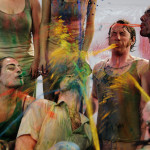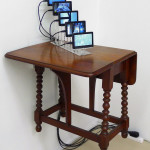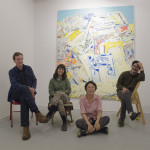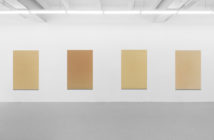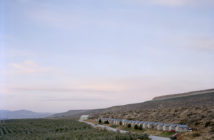kijidome is the brainchild of Sean Downey, Lucy Kim, Carlos Jiménez Cahua, and Susan Metrican. The four artists are inaugurating their collaborative space at 59 Wareham Street this coming Saturday with an exhibition titled S01E01 which juxtaposes works by Dennis Congdon, Oliver Herring, and Elizabeth Riley. I stopped in while they were installing the show to discuss their plans for kijidome.
Stephanie Cardon We can start with the questions that everyone is asking, because I'm sure, as you're announcing the opening of kijidome, people are responding with similar questions. Let's get those answered first.
Lucy Kim The name.
CARDON Okay, the name. Where does "kijidome" come from?
Carlos Jiménez Cahua It's an amalgamation of our names. It means nothing. It has no reference to anything literary or historical. Just our names … squished together.
KIM And in that, it is significant. [Laughs]
Sean Downey Actually, it is significant, because for us part of the focus with kijidome is to make it less about a space—we've hesitated to call this a gallery, because it's not—it's more about us as a collaborative. We're not using it to host show, after show, after show, and so it was important that the name refer back to us, and not something external, like a space.
KIM We also wanted a fun, ambiguous word that wouldn't be too grounded in something specific. People have come up with all kinds of weird, ethnic connotations: "this is Japanese, right?" "It's Nigerian? It's Nigerian." Someone thought it was one of those scams, when I sent them the announcement; they thought the name sounded African, and almost didn't open the email.
CARDON It's catchy. And the word "dome" is appealing too. It brings to mind kingdom, or domicile, shelter … Bucky domes.
DOWNEY Susan and I have had a running joke for years, replacing the word "home" with "dome":
Dome sweet dome … Dome run … Dome away from dome.
Susan Metrican Domeland Security.
CARDON [Laughs] So that's the name. What are some of the other questions that keep coming up?
KIM When I talk about kijidome, I try not to use the word "gallery," so I'll say "collaborative space." And people look so confused. So then I'll say "collaborative project space." And they look even more confused. "You have shows, it's a gallery". The first one is going to be a show, but after that we're going to work on whatever we want, collaborative projects, etc. And it's not a new concept, it's just easier for people to think of it as a gallery. It resolves things faster for them.
DOWNEY That's also the only classification on Facebook that fit. We had to choose a label, and we're not an artist, or an entertainment business, so it had to be "art gallery."
CARDON I wonder why the struggle with this approach. It seems logical to me that as four artists, working together to run the space, you would want to make it about your practice too, whether it's by inviting outside artists you hope to build a connection with, or engage in a conversation, or whether you use the space to conduct your own projects.
DOWNEY That for us was a fundamental idea: this place is an extension of our studio practice. It's an open-ended space we can use to engage in things we wouldn't necessarily engage in at our own studios.
CARDON So how are you hoping to do that?
DOWNEY It happens in the first show, which is a Frankenstein monster of all our sensibilities, in the concept of the show, the artists, the works that we chose. Although, there was a surprising, smooth level of agreement …
KIM Yes, surprising. I'm just looking at Dennis Congdon's paintings next to Oliver Herring's photos. Somehow it makes total sense to us. The thing that binds the work for us is the process of these artists. And that links back to our four practices too. It goes beyond the visual style: they seem related in a deeper way, other than just purely visually.
DOWNEY That's an important thing for us to state, because we all work within disciplines or media, but for all of us our thinking is further outside the individual medium we might work in on a daily basis.
KIM So the next project we're going to do, in December, will be a collaborative project. We're going to paint the whole room chroma key green to change this space into a green screen, and shoot videos in here.
DOWNEY We'll be inviting other artists in to work and collaborate with us. That show will probably exist mostly online, in the form of videos.
KIM For two to three weeks this space will be in use. If you stop in, you'll probably get roped into making a video as opposed to seeing a complete show up.
JIMENEZ CAHUA It's more about production rather than a viewing… And there won't be an opening.
DOWNEY With the first show, going into the studios of artists we really admire and respect has been really helpful. They've all been very generous by giving us very long studio visits that allowed us to go into their process in great detail. That has been very influential. The minute we were in Oliver [Herring]'s studio we had all these ideas. Understanding his process had a way of augmenting what we already do.
KIM We'll take one car, and we'll have a meeting-in-motion where, during the four hour car ride, we basically have to deal with all the issues we're been avoiding. We're very efficient.
JIMENEZ CAHUA It's been quite lovely. For these three artists, we went to their studios—New York, New York, and Providence—all four of us together.
CARDON Did you know any of the artists previously?
KIM We all knew at least one of them.
CARDON It's particularly exciting to me, as an artist, that you would want this to be a generative space for your own practices, and a place that encourages collaboration between you. It's not just that you're four friends, and you happen to get along, you actually see a relationship in the way you work and think, and you're interested in making work together.
DOWNEY And none of us have any interest in becoming gallerists.
KIM Yeah none. Like zero. Your role changes when you become a gallerist. It's easy to become anonymous in some weird way. None of us want that; I think we're all too selfish. A lot of gallerists actually are artists, and you would never know, because you just stop caring—it's sad. We don't want that.
DOWNEY We don't have the skill-set or the capital to be gallerists, anyway.
CARDON I wonder how often artists turn gallerists with the expectation that it will lead to something more generative. And then it doesn't, and it eats up their practice as an artist. It seems important, essential really, that you are laying the ground rules, the foundation, really clearly from the start.
METRICAN That's why we wanted the second thing we do in the space to be project-based. When we first stated planning, we were really thinking exhibition to exhibition. Then when we paused for a second, we realized we had to do an actual project.
KIM So that there's no confusion. Oddly, that puts everyone at ease too in a weird way. I think the word "gallery" just makes other artists tense.
CARDON Well because all of a sudden you're holding some kind of power to evaluate other artistic practices. It shifts people's perception of you.
DOWNEY In practical terms, we built the rotation into the founding concept of the place so we do exhibition projects every other month, not every single month. We still have to think a little bit out, but we have a break to make sure the focus is on our own work.
JIMENEZ CAHUA It also takes us away from a rote activity. Oh, here's another show.
METRICAN During the off months, I'll be able to spread out into this space from my studio [next door.]And then I'll squish back in.
KIM Susan and Sean know each other very well, obviously. [Ed. note: Sean Downey and Susan Metrican are married.] Carlos and Susan went to grad school together. And I teach with Sean. But I'm also new here, kind of. It's not just that we're good friends; I do feel we're still getting to know one another. Our practices tie us together more than the fact that we're best buds, and this changes the way we're approaching things. We goof off and stuff, but we're very serious and professional in our discussions about running this place. We don't have a ton of free time. We're precious about it.
CARDON How do you see your work crossing over? What do you anticipate will make you good collaborators, not just running a space, but potentially in your work?
DOWNEY It's reflected in the first show. The work we've chosen might not intuitively fit, but we see bridges between the work, pointing to this other thing, the higher thing of the process. Our work is very separate and different, but there are these bridges that happen, in terms of sensibility. We all very much like each other's work: even more than being friends, we all have respect for what everyone is doing.
JIMENEZ CAHUA It's a bit artificial, the distinction between curator and artist. There's quite a lot of space between them in terms of connective tissue. An artist creates objects to put out into the real world, and a curator creates a milieu for those objects. It's not that terribly distinct. We're all experienced in putting out objects. To put out a set of objects, and together, isn't all that different: instead of coming out of one mind, it comes out of four. It makes everything a little more messy, but also more interesting.
KIM There are moments when you really see why collaboration is a challenge. We work it out and it's fine. Sometimes you take something back to your studio, because things aren't so streamlined. There can be a glitch. Even choosing artists for the show … there was a huge pile of names. We finally reduced it down to three artists because we didn't want a crazy, crowded show. We wanted it to reflect us. And if we do collaborative stuff, we have an agreement that we want to have worked on the pieces together, not just hang our work side by side. Whether it's an object or a show, it always has to be a collaboration.
CARDON Is there anything you are hoping to see happen to your individual practices as a result of these collaborations?
METRICAN We've talked about doing exchanges with other similar spaces in other cities, like Brooklyn, where these kinds of spaces are very common …
CARDON Name are a couple places you're thinking of in Brooklyn, or elsewhere for that matter.
METRICAN The one we just went to, where Lucy has a show, Ortega y Gasset, is really good.
KIM Regina Rex, TSA (Tiger Strikes Asteroid) … TSA is originally based in Philly, but they now have a Brooklyn branch. They're amazing. There are so many, and they're so different. Field Projects is another. It runs on a different model from the others though.
METRICAN Putting all our powers together we can be an entity that reaches a little further than we could individually. And being in dialogue with other cities is important. That's also why we didn't necessarily want to focus on Boston. Because it's one thing to acknowledge that maybe Boston doesn't have all it needs to be completely confident in itself as an art scene, but we really always want to be reaching out, and not just pointing back at ourselves, in order to make a bigger contribution.
DOWNEY In that vein, I feel that the next project we are doing is a really good way to rope in all the Boston artists that we know, because physically they'd have to be here to participate in this. We don't want to be exclusively looking out, or exclusively looking in. I think either of those models is really problematic. As artists, we see our peer group as existing here, and also existing in other cities, and in other countries. It's a way to enact that.
KIM People move in and out all the time. There are obviously really good artists in Boston, but I do feel, for some reason, that they're harder to find. The doors are shut more often, the shades are down a little more.
DOWNEY Not enough parties …
KIM I swear, that's what it is: there aren't enough parties. In New York, you're just running into people all the time, constantly, because it's so easy to get anywhere, and you don't have to worry about driving home drunk. But we've all had this thought floating in our heads, and it merged at the right time: at some point you're just complaining about stuff. So instead, let's try something.
DOWNEY That's imperative. Whether it's your in own practice or though some other project, you have to be participating in the dialogue rather than just critiquing the dialogue from the outside. This is a really positive way to participate and react.
KIM There are so many good things happening here, and so many interesting people, and obviously there are amazing institutions, but it's also an upside-down pyramid where there are too many powerful institutions. There are artist spaces, but they're struggling because there's not as much critical mass. People don't get around as much. If you go to openings for small, artist-run spaces in New York, they are so packed. People are out. They're just curious.
DOWNEY When we were first going to Bushwick and seeing that model, we could see affordable ways you can lose money on a space. [Laughs] It's been talked about a lot recently in articles: in Boston there is a top-heavy structure, and we all feel there is more need at the bottom of the ecosystem for those kinds of self-generated things, and for bridges within the community. I think Big Red & Shiny, and the way these events bring people together is really important. You realize "oh, there already is a community here," you just didn't know.
KIM It freshens the air. And it has been really nice to have this new exciting project. It's like having a new puppy.
METRICAN I also think Boston really welcomes it. Even the real-estate situation is so much more accessible here, especially with our model because it's part of a studio building. We don't have to behave any differently to keep this space open at this point. We don't have to take any actions, or sell anything, we don't have to alter what we really want to show. From my experience putting together Hung Jury, it was easy, just like one step following another. Being able to access all those spaces that were available is a great way to take advantage of the fact that nobody's here. It's not overloaded with people. The spaces are expensive usually, but temporary use, for a pop-up show, it's accessible. Hung Jury was the first thing Sean and I worked on (and Carlos was in the show) that woke me up to how important it is, and not that hard to do.
DOWNEY People are super thirsty for it, and supportive of it.
METRICAN Even looking from outside of Boston, you think "wow." You couldn't get a space like that in New York, a really big space, in the center of downtown, for $350 a month. There's something here that allows that to happen, and if people feel like taking advantage of it, they can.
KIM Yet, we're not punk rock, just-got-to-drinking-age, idealistic, naïve, showing up for a party. We all have ties to institutions here, we have resources, we also have been professionals for some time, we're all natural administrators.We all have different skills, which is one of the reasons we work so well, and we decided to group together.
METRICAN Artists also can't just make work anymore. You have to play several different roles. You have to be a teacher, or you have to have the other job, and have to have this side gig. You have to have projects …
CARDON You have to because of financial reasons, or because it's what makes you stand out as an artist?
METRICAN I think that's just the way it is today. You can't have a giant loft for $100 a month, and smoke cigarettes all day and paint. You have to have multiple things going all at once.
KIM You have to have a website, for one, or people just think you're weird. [Laughs]
METRICAN It's just what our time demands. And you have to do everything well, or at least try.
CARDON It does seem like we're in the public eye a lot more because of all of these platforms, all of this visibility online, and yet the stakes are pretty high to stand out.
DOWNEY Even thinking of it just in terms of your own practice. I feel this way about my initial feelings about Boston. These can be seen as negatives, impeding your ideal vision of how things should be, or you can switch that and see these as positive things that are really good for your work. It's been great creating kijidome, and seeing the kind of energy it generates for your own work. This model obviously has a huge, long history, and we're just picking up on the history of the artist collaborative, or artist-run spaces, or artist-curated exhibitions, but it also has a unique aspect to it in the way you point out: we are in the public eye, through websites, Facebook, or social networking, and this is a way to use that energy in a positive way instead of just bemoaning how space is expensive, and focusing on all the problems impeding what I could be doing.
JIMENEZ CAHUA In some sense, it's like the academic model. You advance not only your own scholarship but the field's scholarship. You don't just seek publication for your own articles, but you also edit a journal. And you teach.
KIM There's a lot at stake doing this, because we care about it, but there's also not that much at stake. Meaning, because we've been functioning in the universe making art (we're all out of grad school, etc., and we teach), so our studio and the work in our studio has been a pretty solitary practice for us, and it's easy to feel like there is so much at stake. Suddenly to have something like this that is collaborative, where the burdens are shared, allows us to be playful. Hopefully some of that playfulness trickles back into the studio. There are moments, of course, when we're very serious. But it's a different way to think about ourselves as artists. For me, I feel like it's eased the pressure.
DOWNEY We had talked about kijidome in the beginning as a testing ground for things, as an experiment—we've used that word "experimental," even though it's a very loaded word. A playful testing ground for things that we might otherwise feel less secure about introducing to our everyday practice.
KIM Sometimes in your studio you think you've had a brilliant idea, and you write it down. It's nice to not be sure, and to just blurt out a weird idea and immediately hear, "that's stupid!" There's something nice about having an immediate response to a thought.
METRICAN There are now other voices in your head.
DOWNEY We're driving in the car from New York and Susan suddenly says "green screen room," and that starts the seed of an idea. And then somebody else has an idea that grows from that; we mention it to another artist and they say: "Oh I'd like to get in there and do this and this and this..."
CARDON If you think of the audience then, it's not at all a traditional audience. Maybe it is somewhat within the context of this first exhibition, but then the audience is also participator, and in other cases the audience isn't invited at all, or they're invited on your terms.
KIM They're invited, but it's a different risk they're taking. It's not being bored, or finding the person manning the gallery to be snobby. They might actually get roped into something. Or not. Or not know what's going on.
METRICAN In the context of the next project we're talking about, it's also bringing our own individual practices out. With the sübSamsøn residency, Carlos and I both got a taste of that. So that's why I thought "I guess I wouldn't mind people dropping in to see the show while I'm working, I don't think that's going to bother me." That experience at sübSamsøn, at least for me, was really great. It was great to have people come down there and visit me, and talk to me, and I'd keep working, and that's totally fine. It works.
CARDON It's so interesting that process is on display a lot more nowadays. Either that visibility is woven into the practice entirely, or there is someone pulling back the curtain, and saying it's okay to stop in and see the artist half way though something that might end up failing. I still don't know how audiences that aren't completely accustomed to engaging with artists feel about this or respond to it. It's not entirely clear to me. I guess I haven't spoken to anybody who's outside the field to find out how people feel about it. [Laughs.] We have a lot of conversations amongst ourselves.
DOWNEY I guess people that are going into Samsøn and making their way to the basement are already...
JIMENEZ CAHUA It's a sub-set of a sub-set of a sub-set. Who goes in, who goes downstairs, who goes behind.
DOWNEY It's a person who already feels comfortable in that setting.
JIMENEZ CAHUA It's an open studio, but at the same time the people are already coming in ... To go back to what you were saying before about the audience, I don't think it's dissimilar to a studio setting where you invite who you want into the studio. It's not totally private or totally public. And it seems like open studios are terribly common these days. So maybe a good way to think of kijidome is as a studio-gallery. This iteration happens to be a show, the next iteration is more genesis, creation.
CARDON I feel like the open studio model has become increasingly dysfunctional.
DOWNEY It often becomes too much of a passive, institutionalized event that has no spontaneity to it.
CARDON And I notice a similar thing with many alternative spaces and coöperative galleries, which operate in an increasingly professionalized manner, similar to commercial ones, instead of what seems to me like an approach that has the potential to be a lot freer and more fluid, and say: "Okay, we're collaborating on owning this space, what other possibilities does that bring with it?" And conversely, a gallery like Samsøn welcomes creative practices, with few strings attached...
DOWNEY That's a tough thing. In doing this, in spite of everything we've said at the outset, I've noticed it's really difficult for us to try not to set ourselves against the standard of the gallery model. It's really hard not to let that invade your thinking, and to keep feeling playful and generative. Unconsciously even, you look to other galleries to figure out what you need to do based on what they do. There are certain things that are just utilitarian like press releases. We're all pretty new to the Boston area, and have the sense that many of these things have happened here many times before. Looking around, our models are in other cities because we're coming from other cities. In Brooklyn, you have the full spectrum of artist-run spaces that treat themselves very much like galleries, and like artist-run spaces that treat themselves like a process experimental space.
KIM Obviously we're spending money here. The initial investment is there.
METRICAN It's a little bit of a pinch.
DOWNEY Carlos put it really well the other day when we were moaning a little bit about the initial investment we're putting in: Well, if we truly see this as an extension of our studio practice you wouldn't think twice in your studio about dropping a couple hundred dollars to get the supplies and make the work you need, so we have to stick to our guns.
KIM I also think none of us want to do this if it stops being fun to us. I don't know what that means or when that will happen. At the same time, we also know that this is a opportunity to have these amazing works of art here, and obviously we're going to do everything we can to promote these artists, because these artists make work we love and are inspired by.
METRICAN I was really surprised by how pleasurable it was to visit their studios, because otherwise how else do you set up an experience like that for yourself, outside of school, where you can go to visit an artist studio, they welcome you in, and they're really there to meet you and speak to you. It's a gift to yourself.
KIM That said we didn't expect the level of generosity they presented to us.
CARDON I think that most artists are thirsty for conversations with people who intuitively understand what it is they're working so hard for and at, and understand what's at stake. You don't actually get to have those discussions as much as we'd all like. It seems like you're creating a forum to have this discussion amongst yourselves, but also with people you look up to.
DOWNEY If we're putting on an exhibition with these artists it's important to know everything about the work and the process, so we're completely comfortable talking about any aspect it. It was the opportunity to ask every question you might not annoy them with otherwise.
JIMENEZ CAHUA It's problematic though, isn't it, as well? Of course it's good that the artists were so generous with us. Ought that not to be the case generally? SübSamsøn taught me the benefit of the studio visit, not in terms of any career stuff, but in order to have this conversation. Just to draw a comparison to literary people, they don't say to one another: "Oh, let me know the next time you get published and I'll read it." They say: "Give me your poems." Art should be the same way. The studio isn't something from which somebody benefits other than just having a nice conversation. That's what I'm trying to do though this, but also on my own. Rather than waiting for your next show, just show what you have now.
KIM In a way it is a problem, but it's also a completely practical, understandable thing.
METRICAN Wait, what's the problem?
KIM Why aren't artists having these conversations with each other? Why does there have to be a premise to have a conversation?
DOWNEY But we do all have each other. I've had Lucy and Carlos over to my studio. You're having artists over to your studios and having these kinds of dialogues. But the slightly different thing about this was that it was headed toward an exhibition, and so there was a professional layer over the top of it. We really got into the nitty gritty of what's going on in the work. There was less of the friendly, polite situation you usually find in studio visits. That was there, of course, but it also had another dimension.
KIM Also we approached the artists just LOVING the work. Our position to them is clear. We don't need them to explain the work to us, we're going in as admirers. We could all comfortably talk about the work from different angles. To have that kind of fluid conversation with someone … I'm not just letting anybody in … I don't know what that person wants. I don't have time.
DOWNEY And when does a studio visit with another artist ever end in you saying "okay, I'll take this piece, that piece, and that piece." That was a discussion that was funny for all four us to be having in front of the artist, because we obviously love all their work, and if we had a museum space we'd be taking all their work.
KIM It was funny because the artists would have their own preference but were trying not to intrude, and had fun watching us bicker.
JIMENEZ CAHUA Let's just give ourselves the label exhibitor for a sec'. When I go to a studio by myself I apologize because at the end I have to ask embarrassing questions like: "Will that fit in the back of my van?" If it were just a regular artist-to-artist conversation, I wouldn't have to ask that.
CARDON So one last question: are the works for sale?
DOWNEY Yes.
CARDON Are you taking a commission?
DOWNEY Yeah. But smaller than what a gallery would take. We expect to lose money on the space. If we were to break even, that would be just fine.
METRICAN Sales will never be a part of the discussion before the work is chosen.
KIM Absolutely. We obviously talked to the artists, "this is the deal, here's the commission, and are the works for sale?" "Oh well if you can sell them, fine." That was hilarious. They have no expectations of us. They're excited about the show.
DOWNEY I don't think any of our skill-sets fit the business model or art dealer. A sale would be more thrust upon us because the work is so great, and somebody needs to have it, rather than us selling it to them.
CARDON It does all look great. Congratulations.
JIMENEZ CAHUA You've got to be the pig. You know the American breakfast, bacon and eggs, well the chicken contributed, but the pig is dedicated. We're the pig.
CARDON [Laughs] Well you make it all seem very easy.
METRICAN I love stirring shit up. I want parades in the street, and nudity, and confetti. I want to contribute that. We need some more wildness here. Wildness that's more participatory.
- Oliver Herring Areas for Action, Day 15, Color Spit Duet, Davis/Moment of Impact 2010 Digital c-print 16 x 12 inches
- Elizabeth Riley Table with 5 Players 2012 Child’s table, eyeglasses display stand, video players 35 x 24 x 18 inches
- Dennis Congdon Untitled (pile) 2006 Oil and enamel on canvas 87 x 74 inches
- From left to right: Sean Downey, Susan Metrican, Lucy Kim, Carlos Jiménez Cahua Photo: BR&
S01E01: Dennis Congdon, Oliver Herring, Elizabeth Riley, opens October 12th, and runs through November 8th, 2013.
kijidome is located in Unit 1A, 59 Wareham Street, Boston.
kijidome.com and on Facebook.



